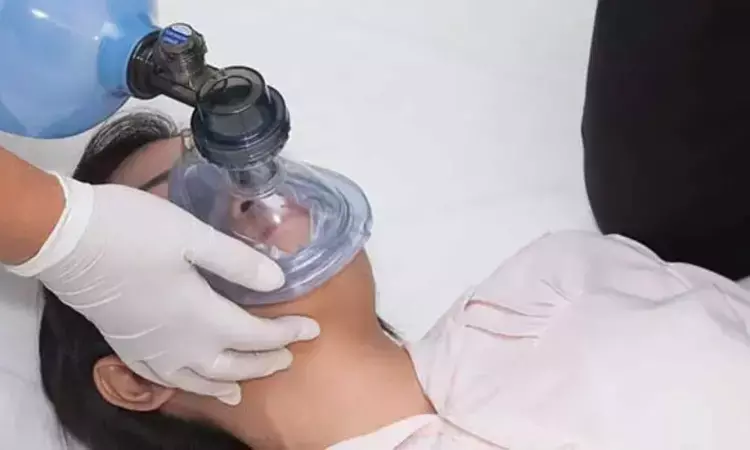- Home
- Medical news & Guidelines
- Anesthesiology
- Cardiology and CTVS
- Critical Care
- Dentistry
- Dermatology
- Diabetes and Endocrinology
- ENT
- Gastroenterology
- Medicine
- Nephrology
- Neurology
- Obstretics-Gynaecology
- Oncology
- Ophthalmology
- Orthopaedics
- Pediatrics-Neonatology
- Psychiatry
- Pulmonology
- Radiology
- Surgery
- Urology
- Laboratory Medicine
- Diet
- Nursing
- Paramedical
- Physiotherapy
- Health news
- Fact Check
- Bone Health Fact Check
- Brain Health Fact Check
- Cancer Related Fact Check
- Child Care Fact Check
- Dental and oral health fact check
- Diabetes and metabolic health fact check
- Diet and Nutrition Fact Check
- Eye and ENT Care Fact Check
- Fitness fact check
- Gut health fact check
- Heart health fact check
- Kidney health fact check
- Medical education fact check
- Men's health fact check
- Respiratory fact check
- Skin and hair care fact check
- Vaccine and Immunization fact check
- Women's health fact check
- AYUSH
- State News
- Andaman and Nicobar Islands
- Andhra Pradesh
- Arunachal Pradesh
- Assam
- Bihar
- Chandigarh
- Chattisgarh
- Dadra and Nagar Haveli
- Daman and Diu
- Delhi
- Goa
- Gujarat
- Haryana
- Himachal Pradesh
- Jammu & Kashmir
- Jharkhand
- Karnataka
- Kerala
- Ladakh
- Lakshadweep
- Madhya Pradesh
- Maharashtra
- Manipur
- Meghalaya
- Mizoram
- Nagaland
- Odisha
- Puducherry
- Punjab
- Rajasthan
- Sikkim
- Tamil Nadu
- Telangana
- Tripura
- Uttar Pradesh
- Uttrakhand
- West Bengal
- Medical Education
- Industry
Hybrid technique effective alternative to bag-mask ventilation to enhance ventilation efficiency, suggests study

Effective bag-mask ventilation (BMV) is crucial for managing the airway and preventing irreversible hypoxia, making it essential for all healthcare providers, including new trainees, to be proficient in efficient BMV techniques. Proper patient positioning, airway patency, and a secure mask seal are vital for successful BMV. Studies have identified various factors, such as edentulous patients, beard presence, advanced age, high BMI, history of snoring, and incorrectly sized masks, as predictors of difficult BMV, which can be addressed by using a two-handed BMV technique with an appropriately fitting mask. Recent randomized controlled study compared the effectiveness of two different bag-mask ventilation (BMV) techniques performed by novice airway providers. One group received BMV using the conventional double-handed CE technique, while the other group used a hybrid technique with the dominant hand in the CE grip and the non-dominant hand on the thenar eminence.
The primary outcome was the 2-minute (24 breaths) mean exhaled tidal volume between the two groups. The secondary outcomes were the number of failed breaths (no exhaled tidal volume) and the comfort level of the airway providers using a 5-point Likert scale.
The study found that the mean exhaled tidal volume was significantly higher in the group using the hybrid technique (476.71 mL) compared to the group using the traditional CE technique (377.51 mL). The mean end-tidal carbon dioxide was also significantly higher in the hybrid technique group (30.42 mmHg) versus the CE technique group (28.83 mmHg). The number of failed breaths was comparable between the two groups, with 4 patients experiencing 2 failed breaths each. The comfort level of the airway providers was also similar, with over 50% finding both techniques very comfortable or comfortable.
Conclusion
The results suggest that the dominant-hand CE and non-dominant-hand thenar eminence hybrid technique provides higher exhaled tidal volumes and end-tidal carbon dioxide levels compared to the traditional CE technique, with similar provider comfort levels. This hybrid technique may be considered an effective alternative BMV method, especially for novice airway providers. The study highlights the potential benefits of combining established BMV techniques to enhance ventilation efficiency, particularly when performed by less experienced clinicians. Further research is warranted to validate these findings and explore the utility of hybrid BMV approaches in various clinical settings.
Key Points
1. The study compared the effectiveness of two different bag-mask ventilation (BMV) techniques - the conventional double-handed CE technique and a hybrid technique using the dominant hand in the CE grip and the non-dominant hand on the thenar eminence.
2. The primary outcome was the 2-minute mean exhaled tidal volume between the two groups, while the secondary outcomes were the number of failed breaths and the comfort level of the airway providers.
3. The results showed that the mean exhaled tidal volume and end-tidal carbon dioxide were significantly higher in the group using the hybrid technique compared to the group using the traditional CE technique.
4. The number of failed breaths was similar between the two groups, with 4 patients experiencing 2 failed breaths each. The comfort level of the airway providers was also comparable, with over 50% finding both techniques very comfortable or comfortable.
5. The study suggests that the dominant-hand CE and non-dominant-hand thenar eminence hybrid technique may be considered an effective alternative BMV method, especially for novice airway providers.
6. The study highlights the potential benefits of combining established BMV techniques to enhance ventilation efficiency, and further research is warranted to validate these findings and explore the utility of hybrid BMV approaches in various clinical settings.
Reference –
Saroye N, Kaur G, Singh U, Grewal A, Khanna A, Nayyar R. Evaluation of efficacy of two bag‑mask ventilation techniques by novice airway providers: Two‑handed CE versus dominant‑hand CE–non‑dominant‑hand thenar eminence techniques – A randomised controlled trial. Indian J Anaesth 2024;68:1010‑5
MBBS, MD (Anaesthesiology), FNB (Cardiac Anaesthesiology)
Dr Monish Raut is a practicing Cardiac Anesthesiologist. He completed his MBBS at Government Medical College, Nagpur, and pursued his MD in Anesthesiology at BJ Medical College, Pune. Further specializing in Cardiac Anesthesiology, Dr Raut earned his FNB in Cardiac Anesthesiology from Sir Ganga Ram Hospital, Delhi.


